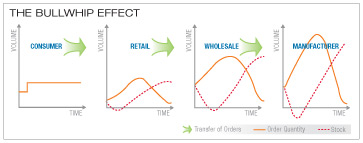No matter how you say it, it's bullwhip
How to work with your customers to smooth out demand forecasts
By Malcolm Mills
I've been fed a lot of bull in my time but it wasn't exactly "bullwhip" they fed me. Like the time when I worked as a purchaser in the Canadian mining industry and a sales guy promised that some Asian-manufactured miner's wrenches were "just as good as Rastall," one of the most popular brands among Canadian miners. Ever been chased around a stock room by a 200-pound hairy miner with a broken wrench aiming for your head? But I digress. I don't mean that kind of bull.
The "Bullwhip Effect" is typically the natural oscillating demand for manufactured products caused by things we all do in our "supply chain" process. I've heard it described as a "lump" of demand. Well we've all taken our lumps, right?
Some of the causes of bullwhip include:
- Stock outs
- Promotions
- Manufacturing problems
- Customer reverses
- Sales forecasting inaccuracies
The list goes on. But it impacts or involves everyone in the supply chain sooner or later, both in sales and procurement.
To the single customer or individual distributor, these oscillations may seem pretty irrelevant. But on a national scale and to the manufacturer that has just increased production due to lack of information or misinformation, it's huge. On the manufacturing end, think of the impact of expediting unplanned raw materials and then rescheduling production to meet unforecasted demand (only to find it is false demand.) Not so small any more is it?
 The point I make is this: The distribution industry has pretty much been full of bullwhip forever, so how many of you have actually ever sat down and explained the effect to your customers? How many distributor sales reps have used this knowledge, this cause-and-effect circumstance, as a selling tool to truly integrate themselves into their customer supply chain? That would have been at least a start in the process of implementing this
The point I make is this: The distribution industry has pretty much been full of bullwhip forever, so how many of you have actually ever sat down and explained the effect to your customers? How many distributor sales reps have used this knowledge, this cause-and-effect circumstance, as a selling tool to truly integrate themselves into their customer supply chain? That would have been at least a start in the process of implementing this
"Supply Chain Integration" process we sales and procurement folk bandy about so often and so glibly.
Acquiring, assembling and distributing knowledge these days is a cake walk. Everyone has access and anyone with a lonely clue has an ear to listen to ways to improve service and profit especially when a flashy PowerPoint takes less than 10 minutes.
I may drive some of you crazy when I say that Supply Chain Integration is the best known tool on the planet today for reducing the bullwhip effect. Supply Chain Integration works, and it's not rocket science. What it is, is hard work driven by an honest motive. Not to mention intestinal fortitude at the corporate level.
Simply put, it means extending the visibility of customer demand accurately, as quickly as possible and as far out as possible. It means putting your cards on the table for your customer to see and having them do the same. It also means not bickering with your own suppliers and make them buy into the integration process also. Now you know why it's taken decades.
I know. You say you've been attempting this forever. That's possibly bull, but it's definitely contributing to all this bullwhip. So why haven't you had more success? We often don't succeed because we don't try and we don't try because we think that as individual distributors you make little impact.
Here's an example. Say Homely Handy Hardware unrolls a huge sales promotion on handy dandy disposable drill bits. Everyone is happy after the promotion because the customers climbed aboard and purchased every last bit in the country, the store made a huge profit, the manfacturer made profits as well. The difficulty, now that the sale is over, is that there is another demand coming right on its heels because these disposable bits will be worn out in a single use and it is the spring building season.
Did Homely Handy Hardware advise the manufacturer in advance of the promotion so they could in turn, give heads up to their raw materials suppliers? Probably not. How about their industrial customers?
Now picture all of the stores across the country doing this.
Another scenario
What about those customers of yours (to many of you that would be those purchasing department snakes-in-the-grass you love to loathe) who place large orders for equipment or supplies, only to have the market fall into a slump and they have to cancel the orders.
It's a bad situation and, again, what has it done to sales forecasting? What impact does it have on the whip? Collectively across the country there is a huge impact. In your little fifedom it's a blip resulting in a comment something like, "Darn! That @@#$% so-and-so cancelled my order!" But picture the national impact.
The cascading effect of bullwhip causes many difficulties. Among them:
- excess inventories
- quality problems
- higher raw material costs
- overtime expenses
- additional shipping costs
- customer service goes down
- lead times lengthen
- sales are lost
So why did I tie Supply Chain Integration into the Bullwhip Effect? Because the two go hand in hand.
So let's talk about supply chain integration. How's that going for you anyway? Would you say you are a close link in anyone's supply chain or just a barnacle on a link somewhere down near the anchor?
Few of us can be Walmart, IBM, Nabisco, Kmart or Kimberly-Clark; we don't have those resources, but we can at least attempt to be. Or we can integrate into someone's plan somewhere. Wally's World is a pretty good example of how to integrate with supply chain partners. Unfortunately, it's a little too large to duplicate. It isn't, however, too large to use as a mentor.
You know what they did. They integrated electronically as many systems as possible between suppliers, their own distributors and with the corporate office. They used select supply chain partners that cooperated fully in providing real-time visibilty in sales, inventories, stock control, finances, category maintenance, process improvement and a whole lot more. And it worked.
Did it pay off, you ask? How many mid-sized towns do you know of that don't have a Walmart?
The point is this: Wally and others set the example. All you have to do is look at what they have done and follow the pattern. Here are a few thoughts to get you started:
- Sort through your customer base and select those clients you believe are good matches for integration with your products and services.
- Segregate. Not every customer is presently a good target for integration. One at a time, form a fit with them or have them fit with you.
- Prepare a sales strategy or even various strategies.
- Start with your own suppliers. How can you integrate systems? Will your systems be compatible with others?
- Begin a teaching campaign. Every time you visit a buyer, plant a seed.
- Open up the information flow. Don't wait for others. Take the lead.
I'm not a sales expert; you are. All I am saying is that purchasing professionals are more than willing to listen if you have something relevant and useful to say.
In its simplest form, it is sharing the appropriate and most accurate information at the right time, and to the right people. It is forming a reciprocal arrangement where all parties benefit and profit.
So, from here on in, how about we cut the bullwhip together?
 Malcolm Mills is a 25 year veteran of the purchasing and procurement field and author of "It's a Tough World Out There – 25 Ways to Lose a Customer 25 Ways to Fit It." Contact him at toughworld@eastlink.ca or (902) 530-5952.
Malcolm Mills is a 25 year veteran of the purchasing and procurement field and author of "It's a Tough World Out There – 25 Ways to Lose a Customer 25 Ways to Fit It." Contact him at toughworld@eastlink.ca or (902) 530-5952.













